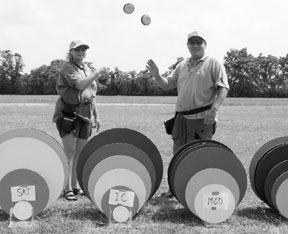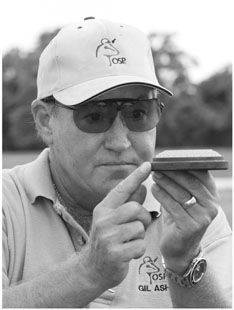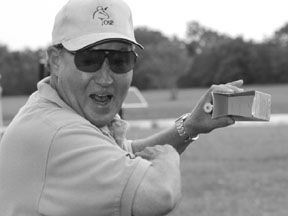
Until recently, I have had a devil of a time consistently hitting crossing targets with a shotgun. I assumed this was because I never shot enough birds in crossing games like skeet to learn the leads. But now I know it was because my gun was in the way.
I learned this seemingly simple, but powerful, notion from Gil and Vicki Ash at the Optimum Shotgun Performance Shooting School in Houston. In a jam-packed one-day session in mid-May, followed by a half-day shotgun-fitting lesson two weeks later, I had my head cooked by Gil Ash in ways that resounded far beyond the traps at American Shooting Centers.
What I remember foremost from the lessons isnt a specific technique (though there were plenty of those), but rather an approach that helps me hit more targets of any type, size, speed, or configuration, with or without a gun.
The most important idea about shooting a shotgun better, or living your life better, is that you must be honest with yourself, Ash said. We find that people are very reluctant to change. However, once our students understand the risks of not changing and the benefits of changing, then change becomes improvement.
Most OSP courses have the shooter firing around 125 to 300 shots, depending upon what you want to work on. Typically, there are five people per instructor per day, and most classes first meet at 8:30 a.m., formally start at 9 a.m., and end at 4:30 to 5 p.m.
Classes may include a mixture of shooter abilities, Ash says. Although we try to group people with like ability, sometimes it just cant happen. We have found that the teaching methods we use can be understood and applied by the novice, intermediate, as well as the advanced shooter. The difference is the more advanced students have the ability to execute the same basic fundamentals at higher levels and on more difficult targets, he said.
Vast Amounts of Information
During my first session, I was amazed at how much I learned when others were shooting. It was easier to see a well-executed move of the shotgun mount, the timing, the barrel placement, and the eye movement when someone else was holding the gun. Ash said, When we explain the same fundamental move or concept to five different people in five different ways, everyone learns so much so quickly!
OSP offers wing and clay target shooting instruction at gun clubs and shooting preserves across the country, but the pair is based in Fulshear, a small town west of Houston. Private lessons are $150 per hour, plus range fees and ammunition.
Understanding Chokes
During my class, there were three men and two women attending. We started the morning by listening to an in-depth presentation on chokes. Standing in front of several banks of colored cardboard disks representing shot-pattern sizes at different yardages, Ash said, The reason you change choke is to give you the largest-diameter shot cloud at the distance you are going to break the target. Lets say that you are shooting a report pair of crossers. The first bird crosses at 15 yards, and the second crosses at 30 yards. If you shot a semi-auto, I would recommend you use an improved cylinder choke with 9s on the close bird and 8s or 7 1/2s on the far bird. There will be a difference in the diameter of the shot cloud at 15 yards using 9s instead of 8s or 7 1/2s, but it will not be very much.
The ideal choke and load for this pair would be to use an over/under with cylinder or diffusion choke with 9s on the close bird and improved cylinder with 8s on the far bird. Cylinder or diffusion choke will yield a 22- to 28-inch-diameter pattern at 15 yards with 9s. Improved cylinder, on the other hand, will yield a 14- to 18-inch-diameter pattern at 15 yards given the same variables. At 30 yards, improved cylinder will yield a beautiful 28- to 30-inch pattern using 8s.
The larger diameter of the shot cloud, the greater the pointing error you can have and still break the target.
After the choke session and out on the range, we broke into two groups, with Gil taking the men and Vicki taking the women. Ash asked us what part of shotgun shooting we wanted to work on, and then began breaking down our preconceived notions of how to shoot a shotgun.
He said, After teaching 1500 people each year for the past eight years, we find that the one main problem that all shotgunners face regardless of ability level is conscious awareness of the gun or looking at the gun. The one main problem is checking the size of the lead.
The beginner has to learn to be 100-percent focused on the target and let the gun enter their peripheral sight circle without looking at it. It is a real struggle because your peripheral circles job is to direct conscious focus to movement. The closer the movement to the face is, the more your conscious focus wants to go to it.

Because the beginner has no trained flow to his gun mount and move to the target, and because he has not trained his conscious vision to stay on the target and accept the gun in the peripheral circle, 90 percent of their missed targets are because their focus comes off the bird and they focus on the gun. The gun stops, and they miss the bird.
Aim Small, Miss Small
The quickest and easiest way to overcome the problem and train both your primary circle and your peripheral circle to do their job correctly is to focus on a small part of the target, what we call the front edge. The more intently a shooter is focused on the front of the clay, the less aware they are of anything else during the shot.
The solution is to learn to focus harder on the leading edge of the target and begin to develop trust in your subconscious computer to put the gun in the right spot to kill the bird. The thing that separates the intermediate shooter from the advanced shooter is a lack of understanding and trust in the subconscious.
I saw this immediately when Ash asked me how much lead was necessary to hit a variety of crossing targets, which I had said gave me trouble. I told him I didnt know – that was the problem – and he said he didnt know either. But he said his subconscious did know, and so did mine.
Disarmingly, he said, Lets try something. It probably wont work, but lets just try it. No pressure, no expectations. Just an experiment.
With those words, I relaxed and accepted the idea that because we were just messing around, and I was open to trying something. He told me to pick a spot to break the bird, and then said to point my gun muzzle near, but below, that insertion point. He then told me to look for a clay coming out of a machine to my right, and to focus on the leading edge (a point on the bird at 9 oclock) of the target, which would cross the sweet spot I had chosen about 25 yards away. I had cylinder/and IC tubes in my Beretta 687 Silver Pigeon 12 gauge.
As the bird left the trap moving right to left, I focused on the front edge, and slowly began mounting the gun to my face. When the gun hit my face, I fired, and the bird broke. Four targets later I had broken five in a row, and I had no idea how much lead I had given the bird.
We moved back 5 yards, and I broke three more. We kept moving back in 5-yard increments and I kept breaking birds all the way back to 65 yards.
Ash said, See, breaking crossers is easy.
I stood slack-jawed at what had happened. It really had been easy.
Performing Positive Self-Analysis
The rest of the day progressed in the same way, with Ash asking questions, but never judging performances. He would ask, Did that mount feel smooth?; What would happen if the gun didnt cover up the target?; Did that feel hurried or on time?; and so on. I began to prompt myself with the same sorts of questions.
During a break, I tried to assimilate all I had learned, when I realized I was exhausted after shooting only about 100 shots. When Ash had said, This probably wont work, but lets try it anyway, he had gotten me to accept a completely new system of seeing and shooting that I had only seen top-grade shooters like Bobby Fowler execute. I had learned to make short, effective moves of the gun in the area where the bird would arrive, called the insertion point. I had learned to match the speed of the bird with the speed of my move, called tempo. I had learned to focus on the target and let my eyes (not the brain) put the gun in the right place ahead of the target. I had learned how to place the gun where it wouldnt block (occlude) my seeing the target, and much more. Most important, I believe, I had learned to be honest about how I hit, or missed targets, and to adjust my approach without reproaching myself.
Even good shooters, he said, will take their eyes off the target to check the lead, a result of conscious doubt. It is the conscious mind wanting to control the situation. They realize that the only way to control conscious doubt is to give the conscious mind something to do – focus on the target! It is at this level that subconscious trust and feel begin to overcome and control conscious doubt and performance begins to excel, and not before.
Conscious awareness of the gun affects shooters of all levels in many different ways, both mechanically and mentally. We believe that anything you can do to become less aware of the gun and 100-percent aware of the target, the better you will shoot.
After thinking over what I had learned, I challenged Ash. If his teaching system was truly technique and target independent, then I should be able to pick up my gun and shoot left-handed, as I had seen him do. He laughed and said, Sure. It may not work, but why not try it? He put me in front of a crossing bird moving fairly fast from left to right about 20 yards out.

I watched the bird come out of the trap and slowly mounted the gun to my left shoulder. I lost sight of the bird because I mounted the shotgun in front of my right eye, occluding the path of the target. He asked me what I saw when I shot, and I replied, The receiver. The next shot I saw the front of the barrel; and the next shot, the top of the rib. On the four shot, I saw the back of the bird. On the fifth shot, I saw the front of the bird and broke it. I then broke five or six more before putting the gun down.
He said, Youve just done what most shotgun coaches will say is impossible. But your experience has shown that it is possible.
Focus, Move, Fire
This is a simple game, he said. Focus on the target, put the gun where the target is going and pull the trigger. Remember, the more exact your lead picture, the more you are aware of the gun. The more you are aware of the gun, the less you know about where the target is. Anything you do that increases conscious awareness of the gun – excessive movement during the mount, moving before seeing the target, being aware of the gun, starting pre-mounted – will pull your critical focus off the target and will result in a miss. Period.
Because of my ability to hit targets Ive never hit before, my improved insights into diagnosing why hits are hits and misses are misses, and my new ability to shoot both right- and left-handed interchangeably, Im convinced Ashs concepts about vision, timing, and tempo have a lot of application for shotgunners of all persuasions. These ideas probably wont work for you, but you might just try them.
-Todd Woodard
For OSP books, DVDs, or lesson bookings, log on to www.ospschool.com.














